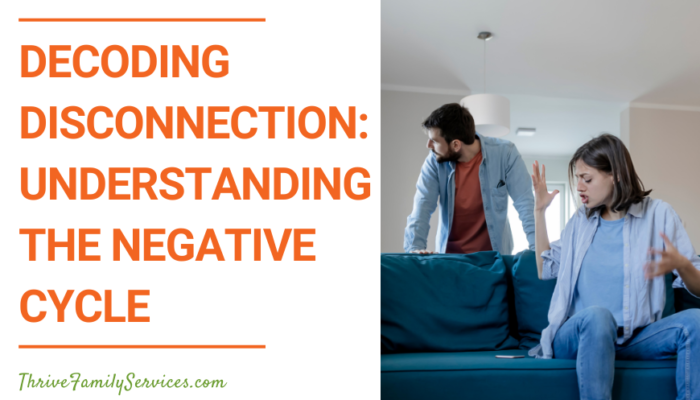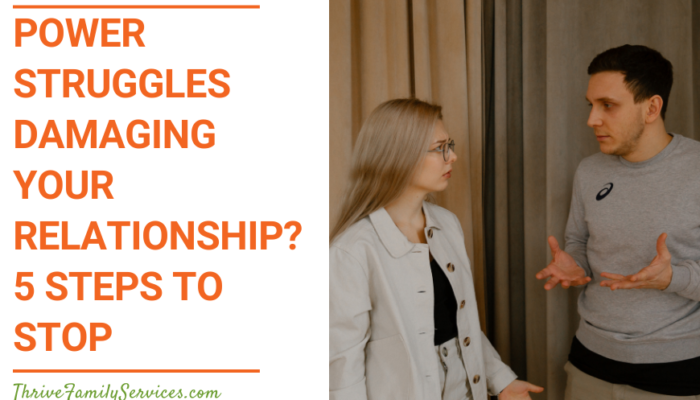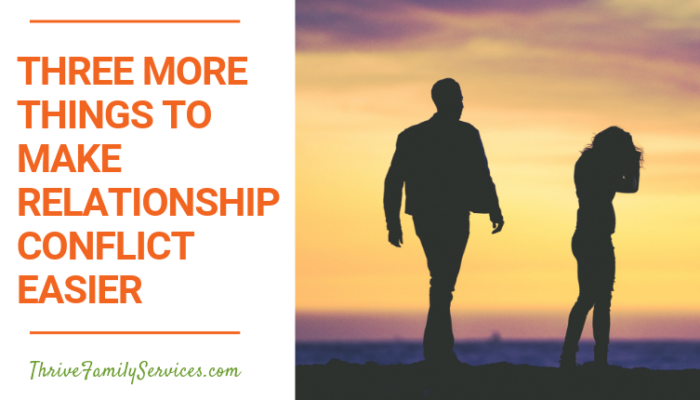Think of the last time you and your partner experienced an interaction that made you feel disconnected from one another. Was there something about it that felt similar to the other times you’ve felt disconnected from your partner? Chances are that there are some similarities that show up during these moments of disconnection. Maybe you feel like you argue about the same thing every time. Maybe the same person always walks away first and the same person always attempts to repair first. Or maybe there’s always a quiet behind-the-scenes build-up that precedes the disconnecting interactions.
Do you ever wonder why?
Sue Johnson, the founder of Emotionally-Focused Therapy (EFT), says, “The person we love most in the world, the one who can send us soaring joyfully into space, is also the person who can send us crashing back to earth.” As a therapist (and a human being), I am sure that everyone in the world knows this to be true. When things are good in your important relationships, everything else feels less troublesome. When things are rocky, however, the rest of your world feels a little harder to manage.
It’s no surprise at all that it is instinctive for humans to go into stress mode when our significant relationships feel unstable. We do whatever we think it will take to prevent disconnection, regain connection, or just stop the pain of it.
Sometimes, people try to stop disconnection in ways that are unclear. For example, someone might slam the cabinet door a little harder than usual to let their partner know they’re unhappy. Someone else might get quiet and withdraw in an effort to not say the wrong thing and risk an argument. As well-intentioned (and normal!) as these signals of distress are, they aren’t as clear as saying, “Hey, I’m not okay, and I need to know that I matter to you.”
Ironically, these unclear signals that are meant to stop disconnection are usually the catalysts for negative cycles between couples that perpetuate distress.
Getting to know the negative cycle that happens between yourself and your loved one is an important first step to changing it.
So often, I hear couples say, “We have the same unproductive fight over and over! Will you just tell us what to do differently so it will stop?”
As much as I wish that there was a magic handbook for how to be better communicators during times of distress, there is no “one size fits all” manual. Instead, getting to know your negative cycle is the best way to be able to change the disconnection you have with your partner. This involves learning to recognize the moves in the negative cycle, understanding the function of it, and being able to talk about your emotions, your needs, and your inner dialogue.
Think of it this way: When a computer stops working, you can’t just google “How to repair my computer.” There are a million tiny factors at play that determine exactly what gets your computer stuck. Instead, you need to be able to describe what the computer does and why the changes started. You need to be able to make sense of the inner workings to know what needs to happen to make the computer start working again.
When it comes to identifying the intricacies of the negative cycle, it’s important to note that human beings only have two options when they’re trying to hold on to the relationship but they don’t feel safe to be vulnerable: avoid emotional engagement or fight for more emotional engagement.
Avoiding emotional engagement happens when a person has decided that disconnection happens because the emotion is unsafe. They might feel that in order to stop escalation, prevent a fight, or to feel more in control, they need to numb out emotions. In EFT, this person would be known as “the withdrawing partner.”
Withdrawing partners often say statements like:
- “I can never get it right, so why try? It’s never good enough in her eyes.”
- “I feel frozen when I see him get upset. I just feel paralyzed. I feel like a failure.”
- “I don’t know how to help, so I just wait for her to calm down. I just tell myself to not make it worse.”
- “I don’t know why he’s so upset. We are fine. Every couple goes through these disconnecting moments. They’re no big deal. We’ll just look for solutions.”
On the other hand, fighting for more emotional engagement happens when a person has decided that there needs to be more communication or more responding in order to feel better. They might start getting demanding, throw out subtle indicators that they want to talk, or express emotion in a protected way. In EFT, this person would be known as “the pursuing partner.”
Pursuing partners often use statements like:
- “I get so mad, but he doesn’t care! But I keep getting angrier because any response from him would be better than no response.”
- “I’m not sure that I matter to her, and I don’t know how to get her to respond to me.”
- “If I didn’t push, we would never get anywhere! Even if I didn’t talk to him for a week, I’m not sure if he’d ever initiate a meaningful conversation with me.”
- “I feel so shut out. Sometimes I feel lonelier in this relationship than I remember feeling when I’m by myself.”
The strategy that a person uses depends on things they’ve learned in their families, in their prior relationships, and in their current relationship.
Therefore, there are three basic types of negative cycles that lead to disconnection: pursue-withdraw, pursue-pursue, and withdraw-withdraw.
Just reading those names might be enough for you to pinpoint what kind of negative cycle you have, but it’s important to get to know more about the negative cycle that you get into with your loved one.
Pursue-Pursue
This cycle of disconnection happens when both partners use the tactic of trying to turn up the emotional heat. The purpose for both people is self-protection, and the main strategies used are accusations and attacks. There is no emotional safety for either person.
This negative cycle starts when one person feels emotionally hurt. In an effort to feel less vulnerable, that person tries to regain control by taking a pre-emptive strike, usually with blame, criticism, etc. Then, of course, the other partner feels emotionally hurt and does the same thing in return.
Take a look at Karen and Ed’s relationship for example.
Let’s say that Karen came home from work and had expected the dishes to be washed. When she walked in the door, she saw the dirty dishes were still in the sink. In her mind, she told herself, “Ed didn’t listen to me. He didn’t care that this is something I asked.” This hurts her emotionally, so she starts making accusations. She says, “Ed, you are so unbelievably lazy! I can’t trust you. No wonder your last wife left you!”
Ed instantly feels emotionally hurt. In his mind, he tells himself, “Karen doesn’t care about me. All she ever does is notice what I do wrong.” He responds by saying, “Well at least I don’t forget to pick the kids up from school like you once did!”
Karen and Ed are in a pursue-pursue cycle because they both make meanings about the other that decrease their lack of safety in the relationship, and they both try to stay protected by not sharing their vulnerabilities. They both feel the impact of their partner’s actions, and they focus on how to let their partner feel the same pain they’re experiencing.
Withdraw-Withdraw
This cycle of disconnection happens when both partners have indicators that avoiding emotion is the best way to stay safe individually and relationally. They both just emotionally check-out of the relationship, although both partners could still be experiencing the pain of disconnection.
This negative cycle develops when both partners are shut down into mutual self-protection by pretending that they don’t need the other and don’t feel anything. Of course, over time, this leads to a total loss of emotional connection because both people’s emotions get denied or withdrawn from. No one is making any emotional reaches or taking any risks to gain emotional closeness.
Richard and Alex are a good example.
Early in the relationship, Richard used to try to connect with Alex in subtle ways like reaching out to grab Alex’s hand, sharing about his day with Alex, and asking Alex out for meals. However, after enough time, Richard started to tell himself, “I don’t think Alex has any interest in spending time with me. I feel unloved, but I don’t want to lose my partner.” So Richard stopped making reaches.
However, Alex grew up in an emotionally unsafe household and learned to just hold emotions inside. When Richard made attempts to connect, Alex’s internal alarms went off. It felt like putting any emotion out there would risk the emotion. Alex’s inner dialogue sounded like, “Richard won’t be interested in me anymore if he gets to know me. We might start fighting. I’m better off just keeping my emotions to myself.” Later, when Alex noted Richard starting to withdraw, those same alarms went off. Alex feels hopeless in how to connect with Richard because he learned that emotions create disconnection.
Now, the two of them live in a house together, too scared to risk rejection so they both deny and suppress their emotions, living a polite relationship.
Richard and Alex are in a withdraw-withdraw negative cycle because they’ve both decided that they need to hide their inner worlds from the other. They are swallowed in a sense of hopelessness that keeps their emotions hidden- even from themselves at times.
Pursue-Withdraw
This is the most common type of negative cycle. A pursue-withdraw cycle happens when one person wants more emotion to connect, and the other person wants less emotion to avoid losing connection.
This cycle of disconnection starts when the pursuing partner wants to feel closer to their partner emotionally. However, they are afraid that their withdrawing partner won’t respond. So they make a reach for connection with a layer of protection up. This protective layer could be made out of sarcasm, nonverbal cues, anger, criticism… anything that they think might get a response from their partner. Then, the withdrawing partner reads this signal as a source of disconnection and moves into a protective position to avoid making the emotion worse. This could look like offering solutions, using humor, shutting down, walking away… anything that they think will make their partner’s unhappiness lessen.
The pursue-withdraw pattern often creates two partners who end up in a spot where neither feels totally satisfied with the level of safety in getting connection because both partners reinforce the other’s fears.
Xavier and Willow have a pursue-withdraw pattern.
In their relationship, Willow is the pursuing partner and Xavier is the withdrawing partner. Xavier has been playing video games for a few hours, and Willow feels sad about a story she heard on the news. Willow tells herself, “I would really like to share my sadness with Xavier, but he seems really into that video game. I would feel rejected if he would rather play his video game than talk to me.” In order to try to connect with Xavier but stay safe from pending rejection, Willow sits down on the couch next to Xavier and starts taking big sighs. When Xavier doesn’t pick up on this signal, she says, “Well I guess you like your video games more than talking to me!” She starts to cry, gets up, and stomps away, hoping Xavier will call after her.
Xavier hadn’t picked up on Willow’s sighs, so when she starts crying and storming off, he tells himself, “What did I do wrong? She must want nothing to do with me right now. If I get up and follow her, she’ll just start yelling and crying. I don’t want to make it worse! I’ll just stay here until she cools off and tells me what’s wrong.” So he doesn’t follow her. Instead, he makes a joke to try to make her laugh.
This reinforces Willow’s fears that Xavier doesn’t care about her emotions and makes it riskier for her to be clear to him about her sadness. So she just groans and walks away. In turn, this makes Willow’s emotion seem riskier to Xavier so he is less inclined to want to go near it to not make it worse.
Willow and Xavier are in a pursue-withdraw pattern because neither partner feels safe to be emotionally vulnerable, but they both use opposing strategies to increase emotional safety. Willow wants Xavier to show more emotion and be more responsive to hers. Xavier feels scared of increasing emotional distress, so he stays far away from emotion.
Do any of these negative cycles resonate with you?
It’s important to note that you could have different patterns with different significant people in your life. The negative cycle that you get into with your mom, your spouse, your dad, your ex-partner could all be different from each other.
Now that you have a better understanding of what your negative cycle looks like with your important person, you can start to catch it and talk about it in different ways before disconnection becomes distressing.
It can be helpful to open a dialogue with your important person so the two of you can be on the same page about what kind of negative cycle you have.
Getting to know the negative cycle in your relationship can make the disconnection less scary and feel less hopeless. After all, every negative cycle is a sign of emotional distress without the safety to risk sharing that distress in a clear, vulnerable way. Once you start to recognize this longing for a safe connection in yourself and in your partner, the cycle starts to change. Instead of seeing your partner as uncaring and stubborn, you might start to see them as scared of losing you and stuck on how to make it better.
Having a partner who is scared and stuck can feel much safer than a partner who seems uncaring and unresponsive!
Here are some questions to ask yourself and your partner to continue learning more about disconnection and your negative cycle:
- When my partner ________________, I start to feel disconnected.
- When I start to feel disconnected, I tend to __________________.
- I do this because I hope my partner will _________________.
- When it doesn’t work, I say to myself that my partner must think this about me: ____________________. (i.e. I am not important to my partner, My partner must not find me attractive, I am failing as a partner)
- I understand that when I tell myself this and start to take those actions, my partner seems to __________________. This makes it harder for us to safely connect with each other.
- The more I ________, the more my partner ___________, so the more I __________. This creates a loop that we get stuck in.




